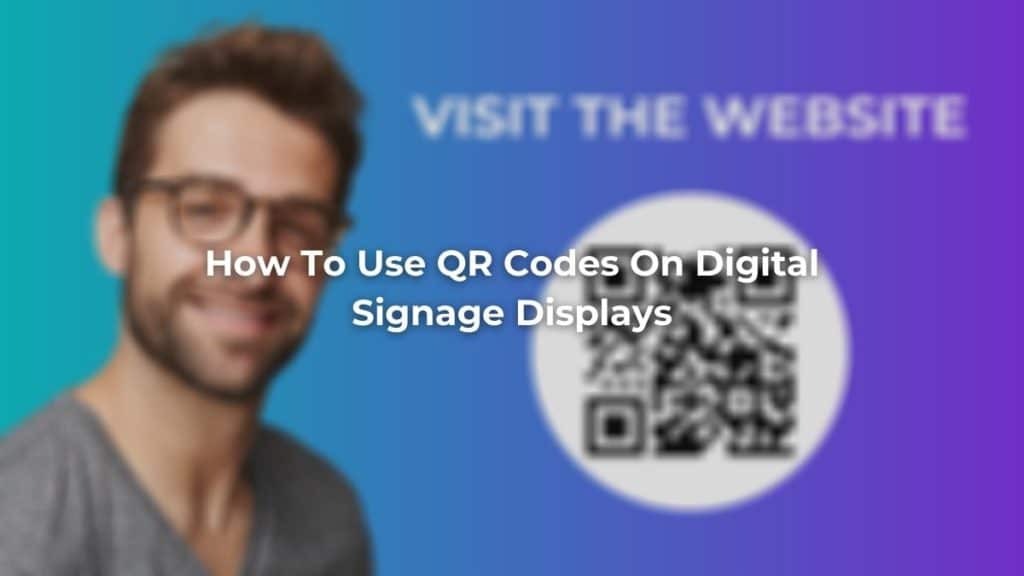Why is using QR codes on digital signage displays a good idea? Recent statistics show that QR code usage is growing fast. According to Medium, the reach of QR codes grew by 28% in 2018-2019. In addition to this, QR code interactions soared by 26%.
The growing popularity of QR codes may be attributed to their efficiency and simplicity. In the past, to access additional sources of information such as a website, form, or app, users would have to type in specific URLs, etc. This extra leg work caused many users to simply not bother. This is because they may not want to spend the time typing in the URL, go to the wrong URL, or find the process frustrating. QR codes remove this legwork. QR code technology allows a user to scan a code with their smartphone and the information loads instantly. Whether it’s a contact form, app download, web page, or digital menu within seconds the user is in the right place.
With the growing popularity of digital signage, users have started to integrate QR code technology with their screens. In this article, we will show you how to use QR codes on digital signage displays. On the way, we will give you tips and tricks on how to effectively use QR codes. We will also provide some use cases to help you get the ball rolling.
Getting Started
Before you decide to embark on your digital signage and QR code journey you need to plan what you are using the QR code for. Are you linking it to a signup form? Digitalise your menu process? Or do you want to directly link users to a support page? There are so many great ways to use QR codes on digital signage displays.
Once you’ve come to a decision, you will need a URL for the page/app download, etc. you want to direct users to. This URL will later be turned into a QR code. Getting the URL is easy. If you are directing users to an online form or a webpage simply copy the URL from the page. If you are directing users to an app download, please ask your app developer.
How To Create A QR Code
It has never been easier to create a QR code. With so many great services out there, you’re nearly spoilt for choice for where and how you generate your QR code. Some services even offer you to customise QR codes with colours and logos to match your branding. The most important aspect, however, is that the process is easy and frictionless.
In the example below, we use Canva to create our QR code. However, the process is near identical for other QR code generators. All you do is select “QR code” from the Canva menu. Enter or paste your URL. Press “Generate code”. You now have a QR code. You can then download this code and use it in your marketing materials and digital signage.
How To Integrate Your QR Code On Digital Signage Displays
Getting QR codes on digital signage displays is simple too. All you need is digital signage software (with the ability to add custom images) and a digital signage display.
In your digital signage software’s content creation dashboard, upload your QR code as an image. Then select the image widget. Drag and drop the widget onto the canvas. Select the QR code from your media library. You can also integrate your QR codes into videos or websites etc.
Once your QR code has been embedded on your digital signage content simply apply it to a playlist and screen. Once you press update your content with the QR code will begin to play on your digital signage network.
QR Codes On Digital Signage Use Cases
Directing Users To A Website
A popular use for QR codes on digital signage is to simply direct users to a website.
For example, a dentist may be offering a deal on teeth whitening. On their digital signage, they can include a QR code on their screens. The patient can scan the QR code where they are taken to a dedicated web page to learn more.
Giving Extra Information For A Product Or Property
This use case is extremely popular in digital signage for estate agents. It’s getting more and more popular for estate agents to display properties on digital displays in their windows. This has provided a more efficient solution to displaying properties in comparison to light pockets. However, estate agents are looking for ways to make the process even more engaging.
An onscreen QR code can be used alongside chosen properties. When a passer-by scans the code they can be taken to a web page. On the web page they can learn more about the property etc.
This logic could also apply to products within a retail store.
Digital Menus
Restaurants are constantly looking for new and inventive ways to reduce their paper consumption. Enter digital menus. Digital menus are paper free and ensure the user is always getting the most up to date menu. For example, relevant specials etc.
The restaurant can place the QR code for the menu on a screen in the window or inside. When a user scans the code the menu will automatically have access to the latest food on offer and promotions etc.
